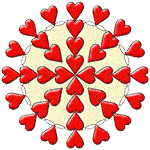

Spend $100 or More & Get 60% off - Use Code BULK60
OR Spend $500 or More & Get 65% off - Use Code BULK65
Spend $1000 or More & Get 70% off - Use Code BULK70
All Sales Final & No Returns. Excludes gift vouchers
Discover more about Malachite, Azurite & Chrysocolla
By Sonia Acone
Combinations of two or more gemstones are not only beautiful, but they also become more powerful as healers, since the properties of each crystal become combined as a whole. An excellent example of this type of alliance is Malachite-Azurite. Both are composed of Copper Carbonate Hydroxide and their chemical compositions are nearly identical – the only difference is that azurite contains less water than malachite. Both of these crystals are found in copper ore deposits, often growing alongside one another.
Malachite is a banded green carbonate mineral, whereas Azurite is a deep blue. The inclusion of copper is what gives these stones their stunning coloring. On the Mohs scale, both have a hardness between 3.5 -4.
An interesting characteristic of Malachite is its ability to pseudomorph Azurite back into Malachite. Pseudomorph means “false shape” and malachite specimens will often transform Azurite's internal chemical composition back into malachite, while still retaining the outward appearance of the azure blue stone. Sometimes Azurite will oxidize into Malachite when exposed to moisture in the air. Hence the reason artists of the past who used Azurite pigments noticed (to their horror) their lovely azure skies turning green over time.
Malachite is a protective stone. It is a stone of healing, self-confidence, peace and business success. It is ruled by the planet Venus and the element of Earth. Malachite can be used on the heart chakra, as well as the throat and solar plexus.
Azurite is also a healing stone. It is a good crystal to use for divination, psychic awareness and creativity. It is also ruled by Venus, but Water it its ruling element. Chakras associated with Azurite are the throat and third eye.
When both Malachite and Azurite combine, the alliance balances the heart and throat energies, thereby enabling a much clearer form of communication.
Another crystal that is often associated with malachite and azurite is Chrysocolla. Chrysocolla is not a true mineral, as it doesn't have a true crystalline structure. It's an amorphous substance, often referred to as gel silica and, as such, it is a mineraloid. Chrysocolla is Hydrated Copper Silicate and it is also found in copper ore deposits. On the Mohs scale, Chrysocolla is very soft, only between 2-4 and it isn't used in jewelry unless it's combined with agatized quartz. Chrysocolla is a pale, sky blue color and is a member of the Silicates class of minerals, while Malachite and Azurite are members of the Carbonates class.
An unusual test to see if a specimen is, in fact, Chrysocolla, is to touch it to your tongue – if it sticks a bit, it's Chrysocolla.
Chrysocolla is a stone of peace, love and wisdom. It soothes emotions and aids in clear communication and intuition. It, too, is ruled by the planet Venus and the element of water. Chakras associated with Chrysocolla are the heart and throat.
Special combinations of Chrysocolla-Malachite-Azurite can be powerful healing stones, especially with matters of the heart (both physical and emotional), communication and protection.
 Well, the tongue test says my chrysocolla is real. It's a beautiful raw chunk with azurite and malachite! (Submitted by: Margie on November 18, 2021) Well, the tongue test says my chrysocolla is real. It's a beautiful raw chunk with azurite and malachite! (Submitted by: Margie on November 18, 2021) |
 You can find these various stones in one called “The Solomon stone” (Submitted by: Empress LL on July 19, 2021) You can find these various stones in one called “The Solomon stone” (Submitted by: Empress LL on July 19, 2021) |
 Awesome info thank you. Can't wait to do the tongue test to see which of these 3 beauties I have. Me and my gf have found a good amount of what we thought was Malachite-Azurite, but seems to be Chrysocolla. Maybe it's all 3!! I'll post when I find out. thanks again for this article. (Submitted by: MalachiteRaven on January 01, 2020) Awesome info thank you. Can't wait to do the tongue test to see which of these 3 beauties I have. Me and my gf have found a good amount of what we thought was Malachite-Azurite, but seems to be Chrysocolla. Maybe it's all 3!! I'll post when I find out. thanks again for this article. (Submitted by: MalachiteRaven on January 01, 2020) |
 Thank you for this wonderfully in depth detail on this combination. Thank you for this wonderfully in depth detail on this combination.And yes, the Chrysocolla sticks! ???? (Submitted by: Laura on October 13, 2019) |
 THANKS (Submitted by: YOCH on September 13, 2019) THANKS (Submitted by: YOCH on September 13, 2019) |
 Great info (Submitted by: Veronica on August 21, 2018) Great info (Submitted by: Veronica on August 21, 2018) |
| Read more articles like this in the following categories: |
| Crystal Healing Articles |
| Crystal Reference Library |
FACEBOOK
INSTAGRAM